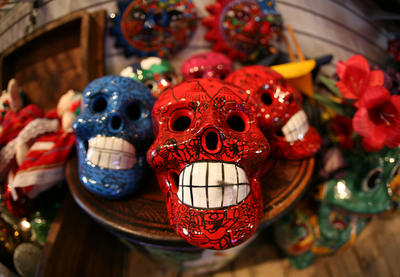Have you seen a lot of sugar skulls (calaveras de azúcar) as Halloween approaches—their colorful, floral designs on front porches, costumes and masks? Have you heard anyone mention “Mexican Halloween”? If so, you’ve witnessed some common misunderstandings and appropriations of Día de los Muertos, which is distinctly different from Halloween in origin, celebration and culture.
Starting at midnight on October 31, families from Mexico and Central and South America begin celebrating Día de los Muertos, the Day of the Dead. Combining Indigenous rituals with Catholicism, celebrants descend on cemeteries to clean the tombs and graves of their deceased loved ones. They sing, dance and bring food and vibrant, colorful decorations. People who don’t live near their loved ones’ graves may instead create an ofrenda (altar) in their home or elsewhere to remember and honor them.
It also happens that monarch butterflies make their migration across Mexico in November, what many believe is a sign that their loved ones’ souls are close as the butterflies pass by.
Día de los Muertos is truly a celebration of life and the beauty of remembering those who have come before us. During this celebration, the dead sort of become a part of the living world, as families tell stories and reflect on memories of them.
Learning about Día de los Muertos in your classroom can be a valuable learning experience for you and your students. Explore the distinct origins of this day and Halloween—where they started, how they are celebrated and for whom they hold great importance. Further, discuss how and why people perceive the two holidays as the same when, in fact, they are not.
Consider a classroom discussion around the Day of the Dead during which students can remember a loved one who has passed away—a grandparent, friend, even a pet. This can be done through a writing assignment or an art project with pictures and objects. Talking about the dead is not something students often get the space to do, and it is a valuable lesson in honoring those we love while building empathy for others. Seeing that their classroom community is full of people who have experienced loss is a common thread that will unite them. Take it a step further and show students that loss is a thread that unites humanity throughout time.
Families themselves are the best resource for learning about the holiday in a culturally appropriate way. How about a guest speaker or family gathering?
Whatever you do, make sure you’re sensitive to students who may be absent during this time, as well as to students who may have strong emotions after remembering the death of a loved one.
Enjoy learning and remembering with your classroom this November 1, and appreciate Día de los Muertos as the unique, festive and joyful occasion it is.
Mascareñaz is the director of Equity Affairs for Wake County Public Schools and a former teaching and learning specialist for Teaching Tolerance.


2 COMMENTS
In Guatemala we also visit loved ones in the cemetery, yet our altars are much smaller and less elaborate than in Mexico... But we make and fly giant kites—more than 60ft in diameter and which take about 40 days to make! It’s said that kites help you communicate with the dead. We don’t eat Pan de Muerto, having instead an intricate everything-but-the-kitchen-sink salad called Fiambre.
Thank you so much for sharing. My classes enjoyed your comment and felt it really got the point across of how diverse the celebration is and important to each of us.